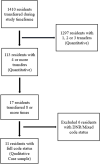Repeat hospital transfers among long stay nursing home residents: a mixed methods analysis of age, race, code status and clinical complexity
- PMID: 35538575
- PMCID: PMC9087933
- DOI: 10.1186/s12913-022-08036-9
Repeat hospital transfers among long stay nursing home residents: a mixed methods analysis of age, race, code status and clinical complexity
Abstract
Background: Nursing home residents are at increased risk for hospital transfers resulting in emergency department visits, observation stays, and hospital admissions; transfers that can also result in adverse resident outcomes. Many nursing home to hospital transfers are potentially avoidable. Residents who experience repeat transfers are particularly vulnerable to adverse outcomes, yet characteristics of nursing home residents who experience repeat transfers are poorly understood. Understanding these characteristics more fully will help identify appropriate intervention efforts needed to reduce repeat transfers.
Methods: This is a mixed-methods study using hospital transfer data, collected between 2017 and 2019, from long-stay nursing home residents residing in 16 Midwestern nursing homes who transferred four or more times within a 12-month timeframe. Data were obtained from an acute care transfer tool used in the Missouri Quality Initiative containing closed- and open-ended questions regarding hospital transfers. The Missouri Quality Initiative was a Centers for Medicare and Medicaid demonstration project focused on reducing avoidable hospital transfers for long stay nursing home residents. The purpose of the analysis presented here is to describe characteristics of residents from that project who experienced repeat transfers including resident age, race, and code status. Clinical, resident/family, and organizational factors that influenced transfers were also described.
Results: Findings indicate that younger residents (less than 65 years of age), those who were full-code status, and those who were Black were statistically more likely to experience repeat transfers. Clinical complexity, resident/family requests to transfer, and lack of nursing home resources to manage complex clinical conditions underlie repeat transfers, many of which were considered potentially avoidable.
Conclusions: Improved nursing home resources are needed to manage complex conditions in the NH and to help residents and families set realistic goals of care and plan for end of life thus reducing potentially avoidable transfers.
Keywords: Advanced practice registered nurses; Hospital transfers; Nursing home residents; Nursing homes.
© 2022. The Author(s).
Conflict of interest statement
Drs. Vogelsmeier, Popejoy, and Rantz are investors in NewPath Health Solutions, LLC.
Drs. Fritz, Canada, Ge, and Brandt declare no competing interest.
Figures




Similar articles
-
Untangling the complex web of avoidable nursing home-to-hospital transfers of residents with dementia.Alzheimers Dement. 2024 Nov;20(11):8038-8047. doi: 10.1002/alz.14292. Epub 2024 Oct 6. Alzheimers Dement. 2024. PMID: 39369299 Free PMC article.
-
Reducing Transfers among Long-Stay Nursing Facility Residents to Acute Care Settings: Effect of the 2013‒2016 Centers for Medicare and Medicaid Services Initiative.J Am Med Dir Assoc. 2020 Sep;21(9):1341-1345. doi: 10.1016/j.jamda.2020.01.002. Epub 2020 Mar 4. J Am Med Dir Assoc. 2020. PMID: 32146040
-
The Complexity of Determining Whether a Nursing Home Transfer Is Avoidable at Time of Transfer.J Am Geriatr Soc. 2018 May;66(5):895-901. doi: 10.1111/jgs.15286. Epub 2018 Feb 13. J Am Geriatr Soc. 2018. PMID: 29437221
-
Decisions to Transfer Nursing Home Residents to Emergency Departments: A Scoping Review of Contributing Factors and Staff Perspectives.J Am Med Dir Assoc. 2016 Nov 1;17(11):994-1005. doi: 10.1016/j.jamda.2016.05.012. Epub 2016 Jun 24. J Am Med Dir Assoc. 2016. PMID: 27349625
-
Experiences and involvement of family members in transfer decisions from nursing home to hospital: a systematic review of qualitative research.BMC Geriatr. 2019 Jun 4;19(1):155. doi: 10.1186/s12877-019-1170-7. BMC Geriatr. 2019. PMID: 31164101 Free PMC article.
Cited by
-
Untangling the complex web of avoidable nursing home-to-hospital transfers of residents with dementia.Alzheimers Dement. 2024 Nov;20(11):8038-8047. doi: 10.1002/alz.14292. Epub 2024 Oct 6. Alzheimers Dement. 2024. PMID: 39369299 Free PMC article.
References
-
- Ouslander JG, Lamb G, Perloe M, et al. Potentially avoidable hospitalizations of nursing home residents: frequency, causes, and costs: [see editorial comments by Drs. Jean F. Wyman and William R. Hazzard, pp 760–761] J Am Geriatr Soc. 2010;58(4):627–635. doi: 10.1111/j.1532-5415.2010.02768.x. - DOI - PubMed
-
- Centers for Medicare and Medicaid Services. Initiative to reduce avoidable hospitalizations among nursing facility residents. Accessed 15 Mar 2022. https://innovation.cms.gov/innovation-models/rahnfr
-
- Office of Inspector General. Medicare Nursing Home Resident Hospitalization Rates Merit Additional Monitoring (OEI-06–11–00040; 11/13). Published online November 2013:28.
MeSH terms
LinkOut - more resources
Full Text Sources
Medical

